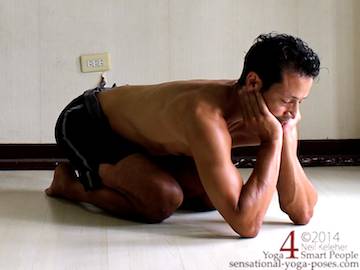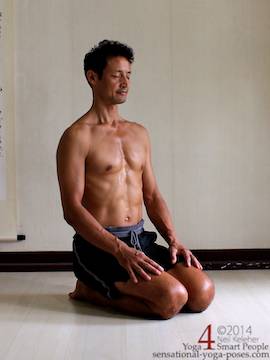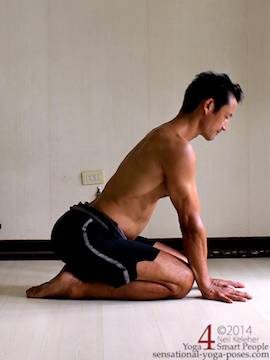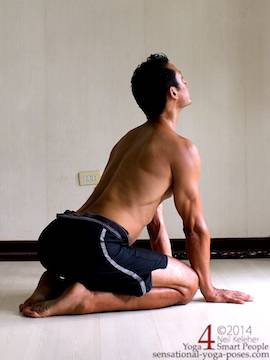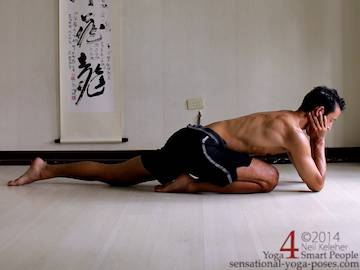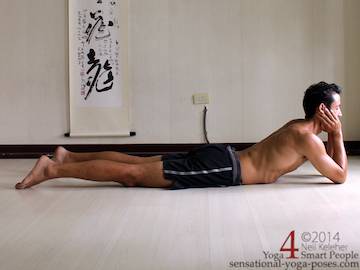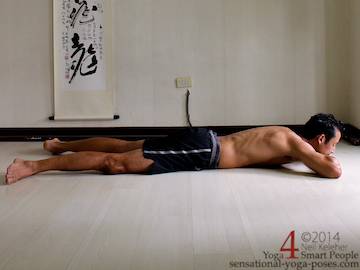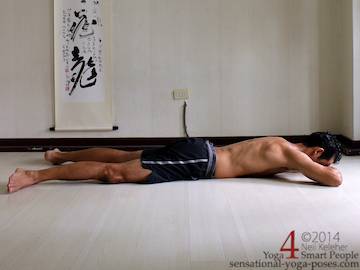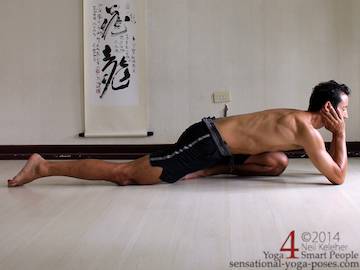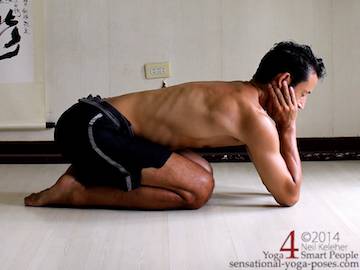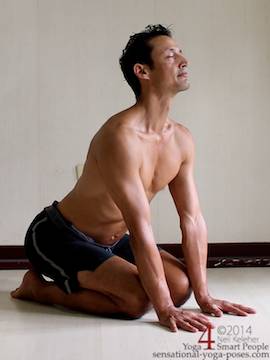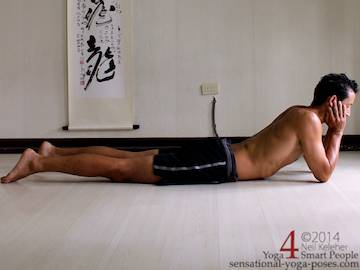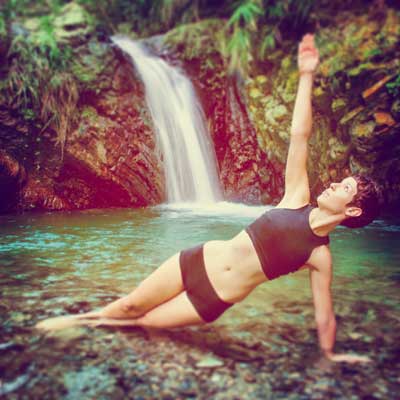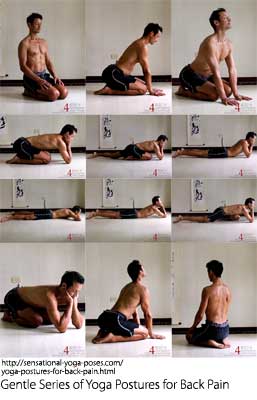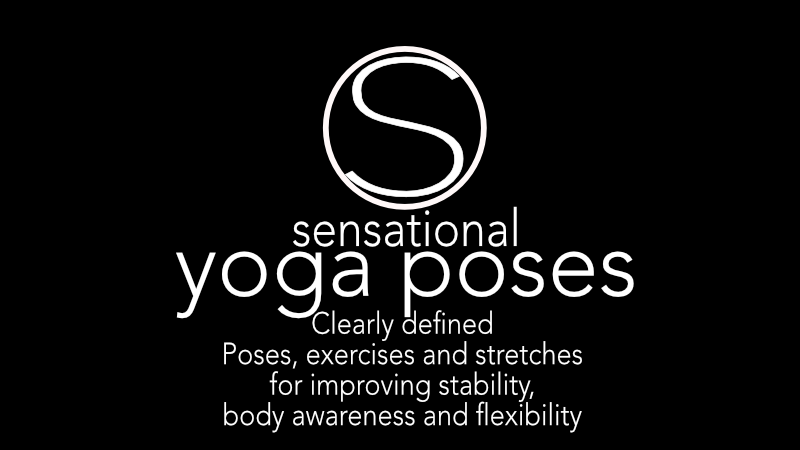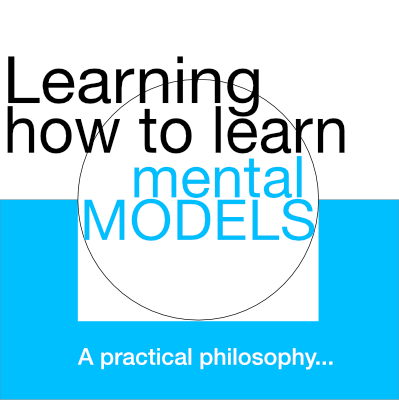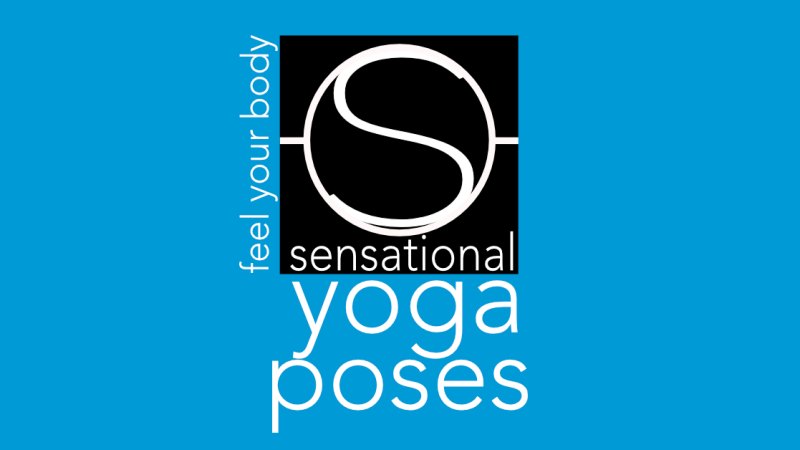Yoga Postures for Back Pain
A series of gentle postures to help relieve low back pain
This is a guest post by Andrea Ridgeway.
During the course of our lives many, if not all of us, will experience back pain.
There are numerous kinds of pain in the back resulting from spinal injury, sitting or standing for prolonged periods of time, bending over while picking up heavy objects without proper knee support, etc.
While yoga and correct posture are helpful prevention aids, when the body is injured or in pain, the following series of yoga postures will aid in relief of back pain.
I learned the Vajrasan Series as part of my Yoga Therapy course at Yoga Point in Nasik, India under the instruction of Vishwas Mandlik.
He developed the program in correlation with his Yoga Sopan course.
I have found the following series, and variations, to be especially beneficial for those suffering from back pain.
Yoga Postures for Back Pain,
General Instructions
- Each position can be held from 15 seconds to 5 minutes, using pillows to increase comfort and ease in the knees and ankles.
Repeat the series as much as needed focusing on relaxation in the position and not in how many rounds are completed.
- I prefer to keep my eyes closed to observe my body but it is not a necessity.
- Regular to deep breathing can be used throughout the series.
- Pregnant women from second trimester onwards and those suffering from serious knee and ankle problems should avoid this series.
The Vajrasan/Kneeling Yoga Routine for Back Pain
1. Vajrasan - Thunderbolt Pose
Vajrasan is basically a kneeling pose with hands on the knees and elbows bent.
While kneeling, close your eyes and focus on feeling and relaxing in turn:
- Your face,
- your neck,
- your ribcage,
- waist,
- hips,
- legs
- shoulders
- and arms.
If you notice any lingering spots of tension, take a moment to focus on those spots.
(Feel free to make any slight adjustments to your posture to allow the parts of your body to relax. Example, when trying to relax the hips, you may find it helps to lean slightly forwards or slightly back.)
Relax your mind.
Gradually deepen your breath, and imagine a particular ailment being healed during the series.
(If you have trouble breathing try this exercise while kneeling.)
2. Januhastasan - Hands to Knees Pose
Januhastasan is a variation of the kneeling position but with hands on the floor just in front of the knees, with elbows straight.
While continuing to kneel, place your hands on the ground directly in front of your knees and straighten your elbows.
Use your arms and shoulders to help lift your chest.
Keep the chest lifted and gradually push your abdomen down towards your thighs so that your pelvis tilts forwards and your lumbar spine bends backwards.
Gradually lengthen your neck (try pulling your ears away from your shoulders) and then slowly tilt your head back to a comfortable position while keeping the body and breath in a relaxed state.
In this position (januhastasan) the entire spine is bent backwards while the hip joints are bent forwards.
3. Hastashirasan - Palm of the Hands to Chin Pose
Hastashirasan is another kneeling variation but with elbows on the floor in front of the knees with the hands cupping the chin
From Januhastasan, bend your elbows (one at a time is fine) and lower them to the ground. Bring your hands upwards and place your chin on both palms with your finger tips touching your cheek bones or ears.
You can separate your elbows shoulder width apart or try to move them together. Friction your elbows back slightly against the floor so that your shoulders move forwards.
Use this action to help elongate your back.
Try drawing your ribs away from your pelvis and gradually make your spine feel long.
Move your elbows forwards or back as you need to.
In this posture the spine (except possible the neck) is reasonably straight with the hip joints bent forwards.
4. Ekpad Sahajahasta Bhujangasan - One legged Cobra Pose to Cobra Pose
Ekpad Sahajahasta Bhujangasan is a transitional pose between the above kneeling postures and the following cobra posture.
Keep the elbows on the mat and your chin cupped in your hands.
Slowly extend your left leg backward with the toes backward.
Rest comfortably in the position.
In this position the front of one hip is being stretched with the spine slightly bent backwards.
5. Sahajahasta Bhujangasan - Hand to Chin Cobra Pose
Sahajahasta Bhujangasan is a laying down/prone yoga pose with the head lifted and chin supported on the the hands which in turn are propped up by the elbows.
From Ekpad Sahajahasta Bhujangasan, slowly extend the right leg backwards so that both legs now reach back.
Keep the chin on the hands.
Close your eyes and rest comfortably in hand to chin cobra pose. Allow your lumbar spine (and lower thoracic spine) to bend backwards and let the bottom front of your ribcage sink down and touch your mat. Then let your waist relax so that it too sinks into the mat. Relax your lumbar spine so that it feels comfortable. Let your thighs and knees sink down also.
Rest comfortably in the position.
6. Makarasan - Crocodile Pose
Makarasan is a prone resting pose with chin or forehead resting on the hands and legs spread and rotated outwards.
Bring your hands to the mat, placing one hand on top of the other, palms down, with elbows on the mat pointed outwards, 90 degrees away from the body.
Rest your chin or forehead on the top of your hands.
Widen your legs, allowing your knees and feet to open outwards so that the inner edges of the feet are on the floor, with heels inwards and toes outwards.
7. Sahajahasta Bhujangasan - Hand to Chin Cobra Pose
Slowly come out of crocodile pose and move back into "chin on the hands" cobra pose.
Position the legs so that they are parallel with the knees pointing down and the toes pointing back.
Move your elbows towards each other and lift the hands off of the mat, placing your chin on your hands.
Again, relax your waist, thighs, and knees so that they touch the mat.
8. Ekpad Sahajahasta Bhujangasan - One legged Cobra Pose
With elbows still on the mat and the palms of the hands sit cupping the chin; slowly bring your left leg forwards, bending the knee and bringing it under the torso.
Rest comfortably in the position.
9. Hastashirasan - Palm of the Hands to Chin Pose
From ekpad sahajahasta bhujangasan bring the right knee forwards so that both knees are bent and you are kneeling again.
Rest comfortably with bent knees and your chin resting in the palms of your hands with elbows on the mat.
Keeping the back straight and long, take long, deep breaths.
10. Januhastasan - Hands to Knees Pose
Place your hands on the floor in front of your knees.
Slowly straighten your elbows.
Bend your lumbar and thoracic spine backwards so that your abdomen pushes down towards your thighs while at the same time your chest lifts and opens.
Lengthen your neck and then slowly tilt your head back to a comfortable position
11. Vajrasan - Thunderbolt Pose
Return to thunderbolt pose by placing hands on the knees with elbows bent while relaxing the face, neck, and body.
Variations
While in Sahajahasta Bhujangasana/Cobra Pose, you can adjust your arms in the following ways to help target specific points in the back.
- By keeping your arms closer to the body you focus on the lower back.
- Pushing your elbows farther from the body results in an upper backstretch.
- If all positions are uncomfortable, you can also take sphinx pose with elbows resting on the mat with lower arms and fingers pointed straight ahead.
Andrea Ridgway
Andrea Ridgway is the director of The Healing Tree which specializes in holistic health aimed at healing spirit, soul, and body through natural non-invasive methods.
Her services are designed to help you understand your bodies individual needs and caringly address mental, emotional and physical stress or imbalance.
She is an Usui and Karuna Reiki Master certified in Ayurvedic Massage and Nutrition and is also Yoga Alliance certified Yoga/Yoga Therapy Instructor.
by: Andrea Ridgway
Published: 2014 08 28
